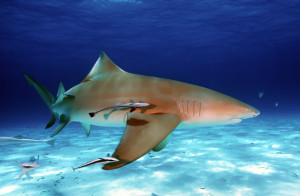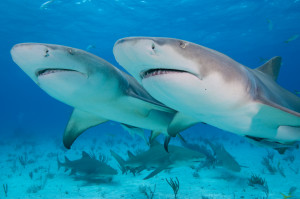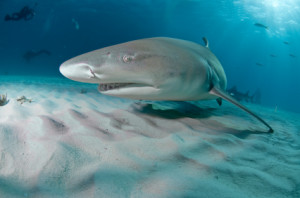Lemon Shark Territory:
Lemon Shark Basic Facts:
Diet: Carnivore
Size: 7.8-11.1ft (2.4-3.4m)
Weight: 190-220lbs (85-100kg)
Life Span: 25+ Years
Group name: School or shoal
Speed: 2 MPH (average)
Lemon Shark Photos:
Photography from iStockphoto
Lemon Sharks (Negaprion brevirostris) are called lemon sharks because of their distinctive yellow color. They tend to stay close to the surface of the water. They also prefer water that is moderate or warm. They are basically loners but sometimes they form small groups. Lemon sharks seem to be able to do very well in any type of location, feeding at the surface or along the sand at the bottom of the water. They are large in size and they are able to defend themselves very well. They have been known to attack people from time to time. Lemon sharks feed on various types of fish that are found in the water. Mainly they stick to small prey that does not fight. They do not require a large meal due to their small size and can go quite a while without food.
Lemon shark commonly attain a length of 7.8 to 11.1ft (2.4-3.4m) and a weight of up to 190 to 220lbs (85-100kg) at adulthood. These sharks have a pale yellow-brown to grey skin, which lacks any markings. It has a flattened head with a short, broad snout and the second dorsal fin is almost as large as the first. Lemon sharks are viviparous, females give birth to a live pup. The birthing cycle lasts for one year and they give birth to 5 to 20 living pups at a time. There are many locations where the Lemon shark is able to thrive. They include the Pacific Islands, the Atlantic Coast, and the Pacific coast. They tend to live in tropical locations around the middle of the water but are often found at the bottom of the sand. They tend to live where remoras are found.
Fun Facts About Lemon Sharks:
- Lemon sharks have electroreceptors concentrated in their heads. These receptors detect electrical pulses emitted by potential prey and the lemon sharks hunt them.
- Lemon sharks are one of the most studied sea animal and shark on the planet. Therefore, scientists have had the opportunity to observe more of their behavior than any other shark.
- Lemon sharks are bottom dweller and they often track their prey by churning up the ground for rays, bony fish, and sometimes even sea birds.
- Like most sharks, Lemon sharks have very sharp teeth but they are shaped differently. They are curved rather than straight up and down. This allows them to easily catch fish that are slippery.
- They have magnetic sensors in their nose that allows them to attract prey. They depend on this sense of smell because they have very poor eyesight.
- Lemon sharks use their yellow color to successfully hide in their natural habitat. They are found swimming along the sand at the bottom of the water so they blend in with ease, so they can hide from predators.
- It is believed that this shark has a special set up with the retina. This enables them to be able to see very clearly even in the murky depths under the water.
- Most Lemon sharks do fairly well in captivity and can live a long time in captivity. They are very social though and they develop a hierarchy based on gender and size that is very complex.
- Lemon sharks are classified as Near Threatened on the IUCN Red List. However they are not currently to be at risk from extinction, still measures are being taken to save them from hunters.



